Remember the needlework Eye-Spy puzzle that I posted for Christmas just … oh, less than a month ago? (Why does it seem like this Christmas is already two years ago?!)
Well, I had several inquiries about different parts of the image, and a few of those inquiries focused on the small book in the upper right hand corner of the picture.
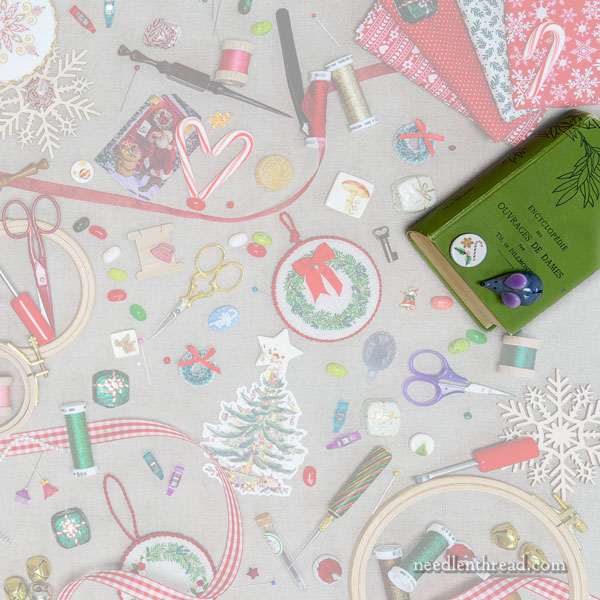
See it?
This is a great little book on so many levels. This particular volume was sent to me as a gift from a reader. She knew I’d love it, not just for the contents, but for the book itself.
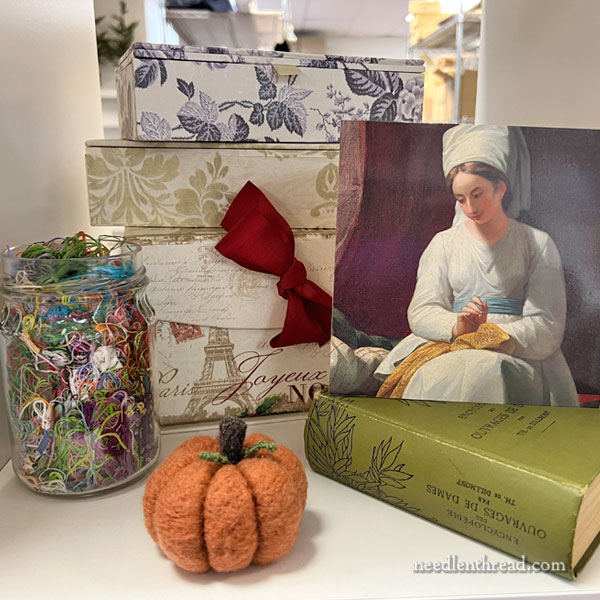
And I do!
This lovely little book is “on display” in the studio in one of the cubby shelves that divide the front part (classroom / work area) of the studio from the back part (shelving, storage, and shipping) of the studio. (You can see the cubbies here, if you’re curious.)
I use about half of the cubbies on the cubby wall as functional storage of working tools, threads, books, and so forth, and the other half to display decorative bits and bobs. Occasionally, we play with the cubbies and re-arrange them – maybe rotating in new color with new seasons and so forth.
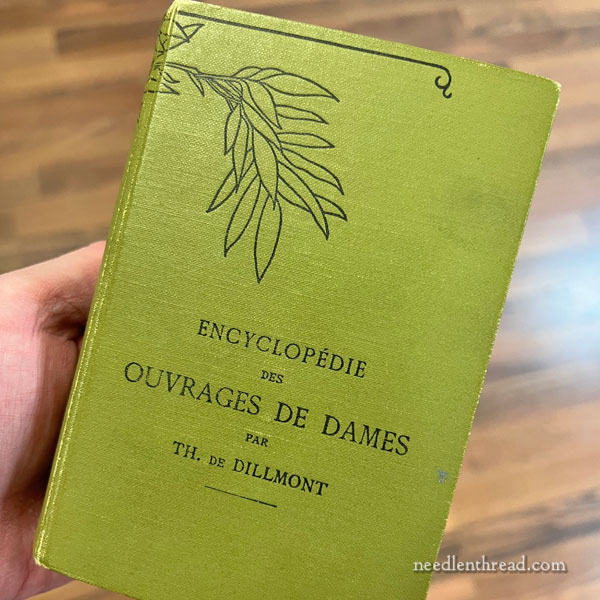
Not only is this edition of Therese de Dillmont’s Encyclopedia of Needlework (in fact, the title is Encylcopédia des Ouvrages de Dames, or Encyclopedia of Ladies’ Work) a trove of useful needlework information, but it is, in its own right, a beautiful little volume.
There is no publishing date in the book. Though it is a somewhat early edition, it is a late enough edition that the “Editor’s Note” at the beginning asserts (this is my translation) that “the Encyclopedia of Ladies’ Work has become the foundation book of any women’s library and its success has exceeded all expectations. Numerous and important editions have been produced, translations have been made into the main languages and printings have reached several hundred thousand copies. During the Chicago World’s Fair, the Encyclopedia was among the forty volumes of French women’s literature deemed most useful for the education of women…”
So, we know this edition was published after 1893 (when the Columbian Exposition, or Chicago’s World Fair) took place, but probably not too long after, since this edition references the notoriety of the book at the Columbian Exposition and uses that as the encouragement for publishing this particular new edition.
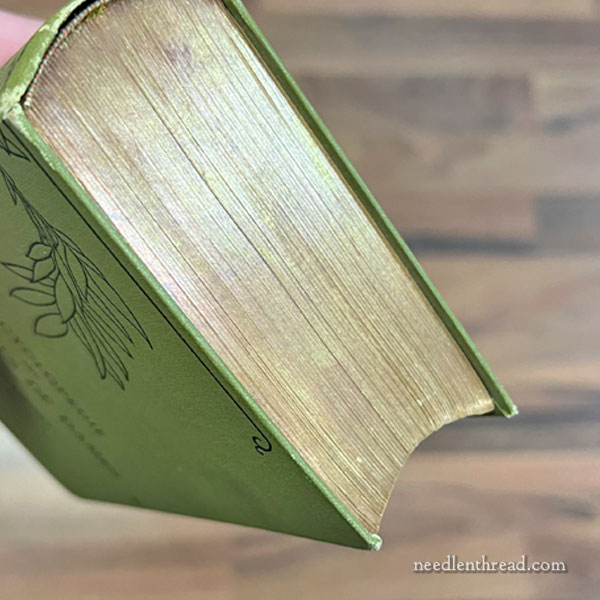
The volume is such a beautiful book in its whole structure. It is small and chunky – 5.5″ tall by 3.75″ wide, and slightly over 1.5″ thick. It has a green linen-like board cover and gleaming gilded page ends.
It looks like a treasured volume of important literature.
And it is!
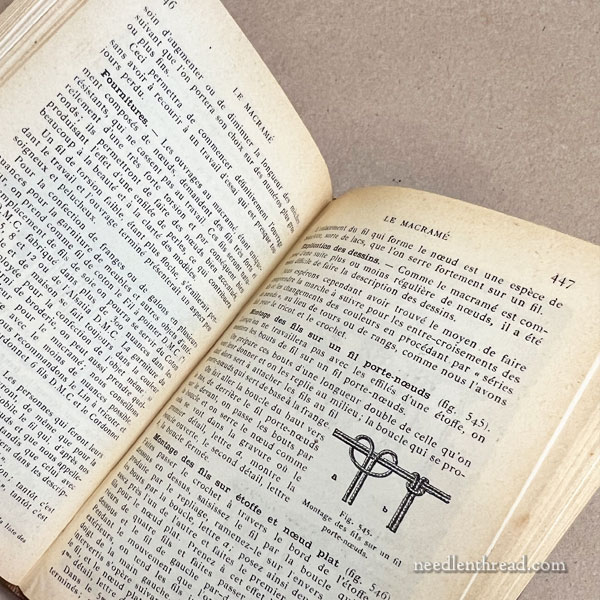
The book is in French, which was the original language of the Encyclopedia.
The print is quite small and compact, and the “plates” or diagrams and illustrations are all very clear.
This edition of the little book is definitely one of my favorite books ever! I love it!
The Encyclopedia Online
If you are interested in perusing the Encyclopedia, you can find it available online through Project Gutenberg. I wrote about it and linked to it here, ages ago.
If you’re looking for other works of Therese de Dillmont, use the search feature on Antique Pattern Library and search “Therese Dillmont” – you’ll find an extensive list of her books available there.
Happy Monday to all! I hope your week is off to a great start!

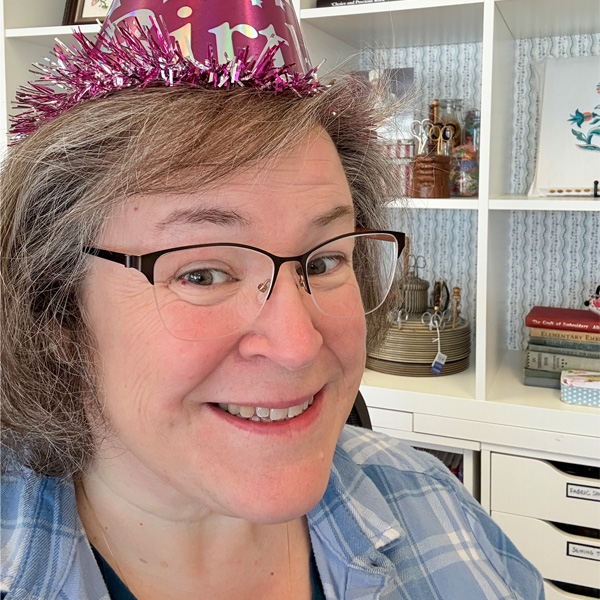
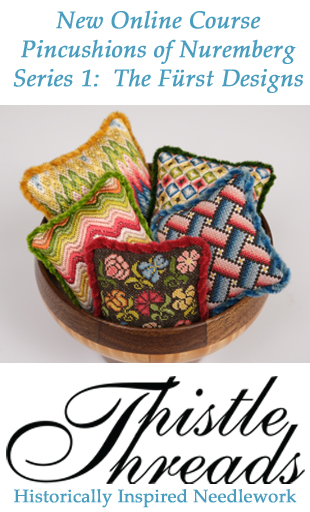

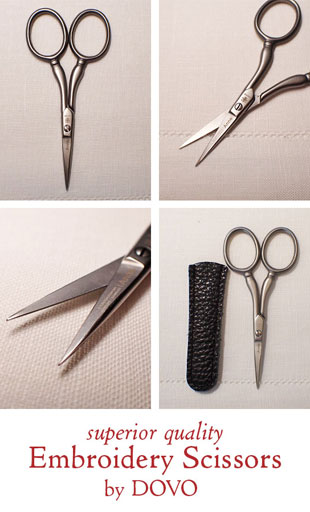
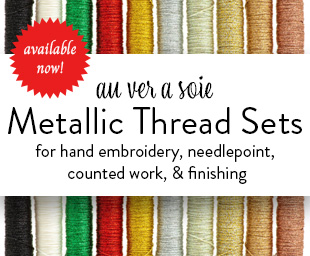
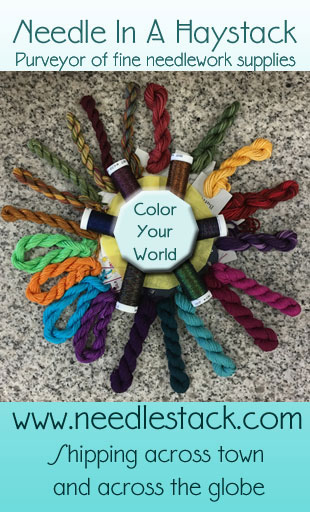
A favorite! I bought the Running Press reproduction, entitled
“The Complete Encyclopedia of Needlework” back in the early 1970s. It was my introduction and method/technique/pattern go to for everything from linen embroidery to thread crochet, and served as such for decades.
I now have a little green edition of my own as well – one of the ones you cite: an English translation published after the Chicago Exhibition, which is cited in the foreword. Like yours, undated. The title page reads “DMC Library, Encyclopedia of Needlework by Therese de Dillmont, New Edition Revised and Enlarged. Th. de Dillmont, Editor, Mulhouse (Alsace).
Same green binding, same DMC endpapers, but no page edge gilding.
One thing that can be very useful with older designs and leaflets is the appendices in my edition. A full list of DMC color names and numbers, plus a visual representation of thread and yarn thicknesses for all of their, with numbers. I was amused to note that black has been #310 dating all the way back to the publication of this little green book. (Whenever that was).
I love consistency! Thank you, DMC! LOL!
Hello Mary, What a pleasant surprise to see you blog about the book I sent you. It was given to me by Cesi Kellinger, who ran a bookselling business specializing in women and the arts. She even has a collection of dance materials she donated to the Library of Congress named after her. I’m so pleased you have given this book a lovely home.
I love that book so much, Kay! It makes me happy every time I look at it. Thank you so much!
What a graceful book! Years ago, my Spanish sister-in-law gave me the Spanish version; I bought the English one later. I discovered it is a great way to pick up another language’s terms for all our specialized embroidery words. Plus, that book has techniques that are hard to find anymore. (Still looking for a tambour thimble like Therese shows!)
Mary, I have the English translation in identical format – binding, size etc. The Editor’s Note on mine follows ‘most useful in women’s education’ with ‘These results have encouraged the editor further to improve and perfect the work. It has been more or less re-cast in the later editions; the several chapters have been revised and extended, new engravings introduced, and a fresh attraction added in the shape of 13 full-page coloured plates [UK spelling], without text. Thus enlarted and embellished, the Encyclopedia of needlework will, we are confident, find ever-growing favour.’
I have an english version. Love it.
Hello Mary,
It’s very windy here, very wet and cold. So I’m passing time by searching the internet. This week the quest is for whitework embroidery and I turned up your website. I might be able to throw some light on Therese de Dillmont’s “Ouvrages de Dames”.
I have five (!!!) copies. The first one was given to me when I was a teenager, it having been found when some Victorian houses were being demolished in the 1960’s. People moved out leaving anything they didn’t want to whoever found it.
My first copy is a pocket edition, in English, and dates from October 1932. How do I know this? The dates is on the reverse of the title page, right at the bottom in the following form – 1032. At this time 1,395,000 copies had been published. Some years ago I did a bit of research from the bobbin lacemakers of Arachne (on-line e-mails) and amassed a great deal of info. I also have a French copy with 960,000 copies printed and which dates from May 1923 – 523.
My earliest encyclopedia is an English edition. There’s no date printed, but the original owner had written her name – Holmes; address – Windermere and the date – 1895. I think this is a very early edition, possibly a first edition, as there is no mention of the Chicago World Fair. There are lots of differences between this edition and later ones. All the other copies have a code for the date and the numbers of copies printed. Each language, French, English and German seem to have a different number of copies. The last copy that I have is a reprint from 1970’s and very poor reproduction, but cheap to buy, just to complete the set.
If you want to know anything else, please let me know.
Best wishes,
Liz Pass